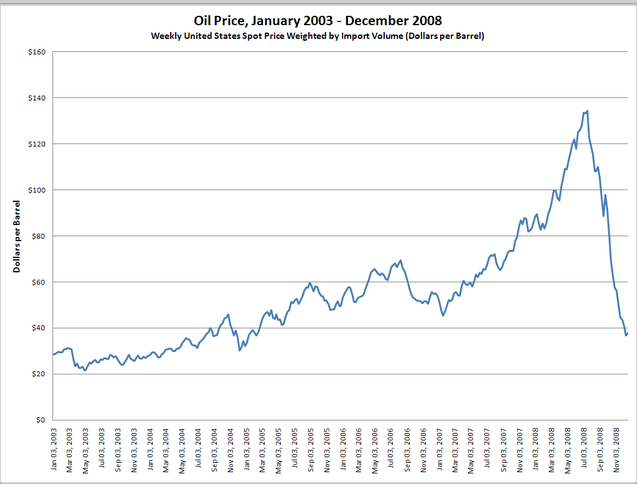The $700 billion bionic economy
In the 1970s television series, The Six Million Dollar Man, test pilot Colonel Steve Austin was nearly dead from a test flight crash. Deciding that “we have the technology to rebuild this man”, the US government rebuilds Austin, augmenting him with cybernetic parts giving him superhuman strength and speed. Austin becomes a secret operative, fighting injustice where it is found.
Thirty years later in 2008 in the real world, the US economy has crashed from profit testing gone wrong and was on the verge of collapse. Deciding that “we have the means to rebuild this system”, the government decided to rebuild a defunct system and turn it into the $700 billion bionic economy. Augmenting it with taxpayer dollars, top executives of irresponsible financial institutions received $1.6 billion USD worth of super-economic strength and speed, like bonuses, home security systems, private chauffeured cars, club dues, and private financial planners–no irony there– just to name a few. The bionic economy became an overt government operative, rewarding financial injustice where it was found.
Definitions of a nixed economy, a defunct mixed economy, and a bionic economy
nix: to stop, prevent, or refuse to accept something (Source: Online Cambridge Dictionary)
nixed economy: an economic system which has been stopped, prevented, or refused to accept the consequences of its own behaviors
defunct: no longing existing, living, or working correctly (Source: Online Cambridge Dictionary)
mixed economy: an economic system in which some industries are controlled privately and some by the government (Source: Online Cambridge Dictionary)
defunct mixed economy: a mixed economy that no longer exists, lives, or is working correctly, whereby major industries are controlled by the government
bionic: using artificial materials and methods to produce activity or movement in a person or animal (Source: Online Cambridge Dictionary)
bionic economy: an economic system in which major industries are controlled by the government through the use of artificial materials and methods to produce desired activity in an otherwise defunct economy
A nixed economy: The Free World not living in accordance with a mixed economy
Oil surge and Iraq War
From the mid-1980s to 2003 a barrel of oil had remained around $20 to $40 USD. The energy crisis from 2003 to 2008 culminated in a barrel selling at a record high of $147 USD in July 2008. On March 20, 2003, the United States coincidentally began its invasion of Iraq, based on false intelligence–the world’s No. 4 in oil reserves. In May 2007, as the barrel of oil was soaring, the Iraq Oil Law was proposed. The law intended to give major western oil companies long-term contracts and a safe legal framework to manage oil fields in Iraq. Due to internal conflicts this proposed law triggered–further inciting instability in the region–no law was passed.

The Housing Bubble, Subprime Mortgage Crisis and Market Crash
On September 15, 2008, Lehman Brothers filed for Chapter 11 bankruptcy protection. The financial services firm had a whopping $600,000,000,000 in assets–the largest bankruptcy filling in US history. In a bid to save an ostensible global collapse of the banking and economic system–since it is unknown how a mixed economy would have handled the situation–the Bank Bailout Bill was submitted to the House of Representatives on September 21, 2008. But many in Congress felt it was forcing taxpayers to reward bad banking decisions. The House voted against it on September 29, 2008. The result: That same day the stock market crashed. The Dow fell over 770 points, the largest point drop in any single day in history and global markets plummeted.
The Senate quickly re-introduced the proposal by attaching it to a bill that was already under consideration. The Emergency Economic Stabilization Act of 2008 was approved and signed by President Bush on October 3, 2008. Less than two months later on December 30, 2008, the housing market also met its fate. On this date, the Case-Shiller home price index reported the largest price drop in its history.
The subprime mortgage crisis was in full swing between 2007 to 2010. During this time period over 60 notable financial institutions worldwide–including the likes of Fannie Mae and Freddie Mac and American International Group–the two alone had a combined value of nearly $200 Billion USD–were either acquired or went bankrupt. From 2006 to 2012, half of the United States–this writer was almost a victim as well–would be affected by the credit crisis and bursting of the housing market bubble. In 2008 alone, 3.1 million Americans filed for foreclosure, which at the time was one in every 54 homes, according to RealtyTrac. The repercussions were long-lasting. By 2016, homeownership in the U.S. had dipped below 63% – a 50 year low. (Read more at Investopedia)
Auto industry bailout
It is surprising that from 2008 to 2010 the auto industry would take a turn for the worse, with the “Big Three” approaching Congress in November 2008 to request an over $80 Billion government bailout or face bankruptcy? A major tenet of Capitalism is limited government intervention whereby free markets are free from any government intervention. Unless one views the $80 Billion bailout from January 2009 to December 2013 as “limited government intervention”, then by these definitions neither the rules of capitalism nor mixed economy was followed.
Timeline of Complete Economic Failure in 2008
July ’08 – A barrel of oil sold at $147 USD – Highest price in history
September ’08 – Lehman Brothers files Chapter 11 – Largest bankruptcy filing in US history.
Emergency Economic Stabilization Act is not passed by the House and the Stock Market crashes – Historic one day 770 point drop
October ’08 – Emergency Economic Stabilization Act – Financial Institutional $700 billion USD bailout signed
November ’08 – $80 Billion auto bailout – Largest auto bailout
December ’08 – Largest home price index drop in Case-Shiller history
The dangers of a bionic economy
The imminent danger of having an artificial economy is that those who interfere with free or even mixed economies ultimately control the parts. When a bone breaks and heals naturally, then the body itself is in control of the healing process. When that part is artificially replaced, as was the case in 2008, then it is no longer a natural healing process. It is an unnatural intervention with predetermined goals serving the interests of those in charge of the replacement.
No one will ever know what the aftermath would have been like had the nixed economy taken its natural course. The “Great Recession of 2008” showed a complete and utter economic collapse. Was it a sign that a new system is needed?
Who benefits from a bionic economy? According to a Federal Reserve Bulletin published in September 2017, as of 2016, the richest 1% of Americans owned 38.6% of the wealth. The bottom 90% owned only 22.8% of the wealth. That is nearly twice as much. The three richest Americans hold more wealth than the bottom 50% of Americans. And the wealth gap is only widening.
A bionic economy devalues money and human life
Check out the article November 2017 Market Watch article titled, Here’s all the money in the world, in one chart. The ratio of hard currency–$36.8 Trillion, compared to non-tangible wealth–$1.2 Quadrillion is mind-blowing! In other words, physical money consists of only 8% of all worth in the world. The non-physical “money” makes up 92% of all wealth.
Here is more sobering news about the bionic economy. Global debt is estimated at $215 Trillion ($250 as of 2019). That means global debt is almost seven times greater than all the hard cash in the world! How would the average person be treated by a financial institution asking for additional funding if, for every dollar he had, he already owed seven?
Ready for another amazing bionic economy feat? $70 Trillion (33%) of that debt was accumulated in the last decade alone. Despite a recent warning of a global debt crisis from the World Bank, the bionic market keeps ongoing. How long and on what foundation can the bionic economy perform as it has been? What value does money really have and who is benefitting from this bionic economy?
Remember the 3.1 million Americans whose dreams of homeownership were used to lure them into a borrowing financial trap? Where was their bionic compensation for being negligently counseled and losing their home? Where was their bionic loan to bring them back to life and save them from foreclosure, bankruptcy, and emotional hardship? Interesting how the mixed economy was good enough for the millions of victims to recover naturally, but not for the perpetrators! A bionic economy not only questions the value of money, but it seems to call into question the value of human life as well.
About the author
Jean-Pierre Kallanian is a Process Facilitator and Human Systems Expert. He accompanies organizations in fully integrating their human resource potential by facilitating group processes that foster authenticity, intention, and collective wisdom. He is also the author of What You Can Learn from Your Teenager: Lessons in Parenting and Personal Growth.

